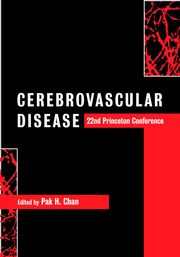Book contents
- Frontmatter
- Contents
- List of contributors
- Preface
- Acknowledgments
- Part I Special lectures
- Part II Oxidative stress
- Part III Apoptosis
- Part IV Hot topics
- Part V Hemorrhage, edema and secondary injury
- Part VI Inflammation
- Part VII Gene transfer and therapy
- Part VIII Neurogenesis and plasticity
- 25 Transplantation of neural stem cells: cellular and gene therapy in pediatric hypoxic–ischemic brain injury
- 26 Neural plasticity after cerebral ischemia
- 27 Environmental effects on recovery after stroke
- Part IX Magnetic resonance imaging in clinical stroke
- Part X Risk factors, clinical trials and new therapeutic horizons
- Index
- Plate section
27 - Environmental effects on recovery after stroke
from Part VIII - Neurogenesis and plasticity
Published online by Cambridge University Press: 02 November 2009
- Frontmatter
- Contents
- List of contributors
- Preface
- Acknowledgments
- Part I Special lectures
- Part II Oxidative stress
- Part III Apoptosis
- Part IV Hot topics
- Part V Hemorrhage, edema and secondary injury
- Part VI Inflammation
- Part VII Gene transfer and therapy
- Part VIII Neurogenesis and plasticity
- 25 Transplantation of neural stem cells: cellular and gene therapy in pediatric hypoxic–ischemic brain injury
- 26 Neural plasticity after cerebral ischemia
- 27 Environmental effects on recovery after stroke
- Part IX Magnetic resonance imaging in clinical stroke
- Part X Risk factors, clinical trials and new therapeutic horizons
- Index
- Plate section
Summary
Introduction
There is increasing evidence that functional improvement after permanent brain lesions is related to lesion-induced plasticity in the intact brain. An important question is to what extent postischemic interventions can influence plasticity and functional outcome after brain infarction. We have shown previously that sensorimotor functions improve significantly more in rats that are postoperatively housed in an enriched environment than in rats housed in standard laboratory cages. In a comparison among different kinds of activities, social interaction was superior to wheel running, and an enriched environment allowing free physical activity combined with social interaction resulted in the best performance. We have also shown that enriched housing can improve outcome after neural grafting to a neocortical infarct. I will discuss some studies on potential mechanisms behind the environmental stimulation of outcome after focal brain ischemia.
In the studies quoted below, cortical infarct was induced by ligation of the middle cerebral artery (MCA) distal to the striatal branches in 3- to 4-month-old male spontaneously hypertensive rats. Before the operation all rats were housed in standard cages, four rats in each cage. During the first 24 to 30 postoperative hours they were housed in individual cages, then either returned to standard cages or transferred to larger cages, furnished with horizontal and inclined boards and equipped with various items. Twice or three times a week the space between the boards was changed and some objects were replaced with new ones.
- Type
- Chapter
- Information
- Cerebrovascular Disease22nd Princeton Conference, pp. 328 - 336Publisher: Cambridge University PressPrint publication year: 2002



